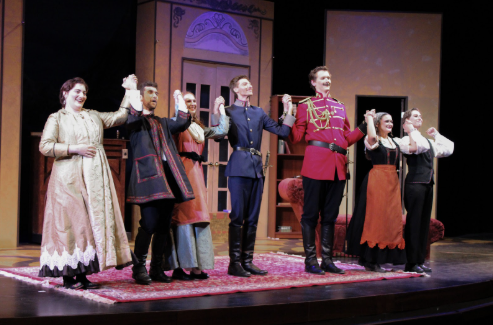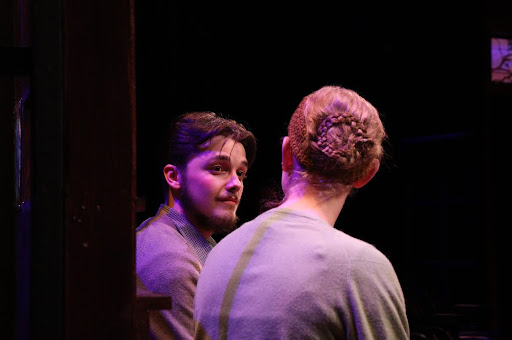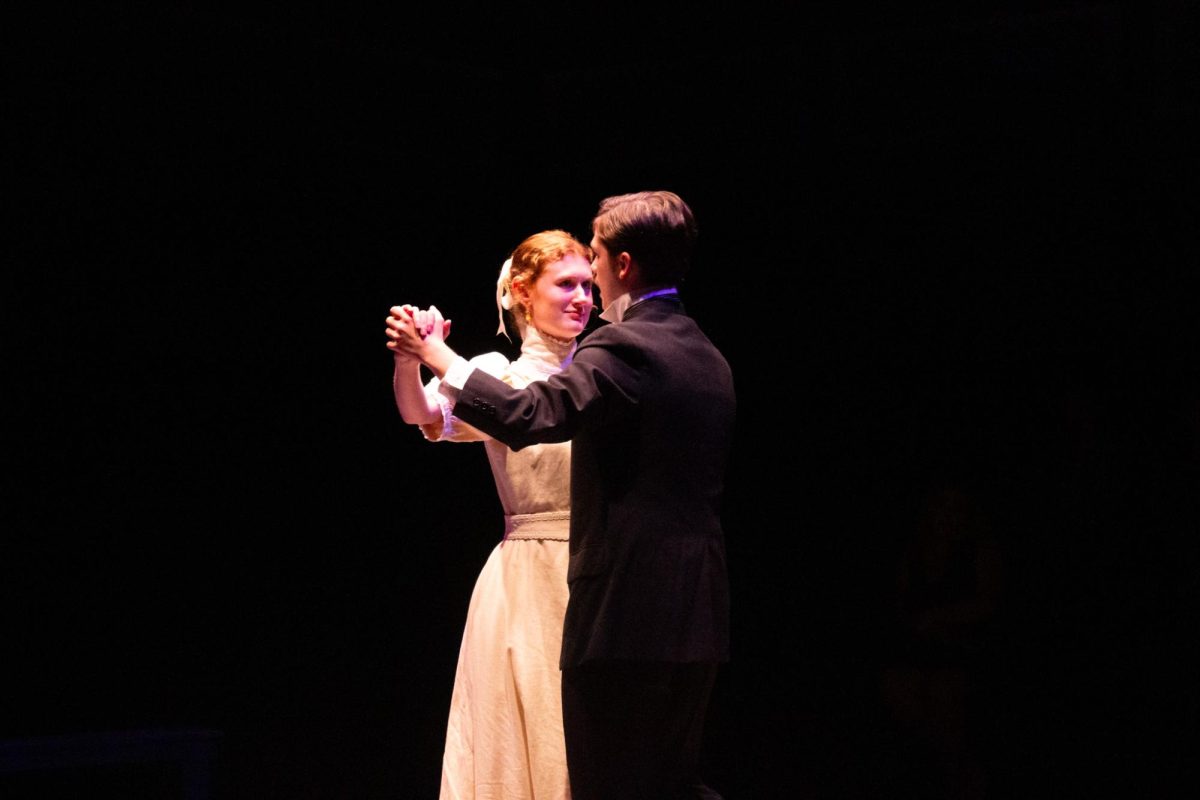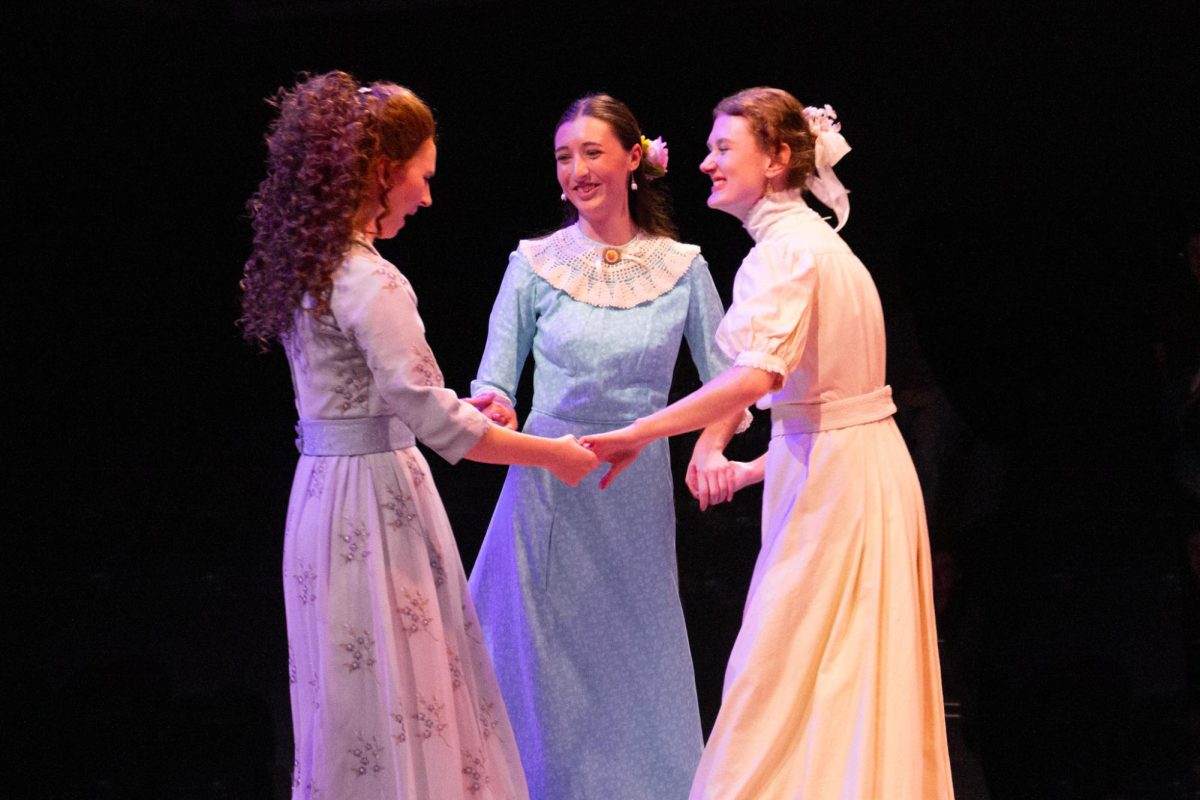
*It’s important to note that the author of this piece was also a performer in this production. The Captain’s Log Editor-in-Chief has granted permission due to the nature of the article, but encourages readers to understand there is a potential for bias in this article
In the middle of the night under a cloudless sky, a young Bulgarian woman’s life is threatened in her own room by an enemy soldier. A soldier slips in through the balcony – not the dashing hero of patriotic dreams, but a weary man with chocolate in his pockets instead of bullets.
Directed by Professor Denise Gillman, Christopher Newport University’s (CNU) first production, “Arms and the Man” by George Bernard Shaw, offers a bold retelling that is clear from the moment the lights dim. Set during the Serbo-Bulgarian War of 1885, the play plunges into satire, romance and the strange human comedy of war and love.
The story centers on Raina, (pronounced as “Ray-E-Nah” and should be said with a magnificently rolled “R”) played by Olivia Hargest, who dreams of noble soldiers and glorious battles – until a disheveled Swiss mercenary, Captain Bluntschli, climbs through her bedroom window, seeking refuge.
Blutschli, played by Anthony Hearn, shatters Raina’s illusions with his dry humor and unromantic views of warfare. Raina begins to question her own engagement to the vain war hero Sergius Saranoff, played by sophomore Brett Conway, and her understanding of love, true courage and herself.
On the stage of the Peebles Theater, Dave Shuhy, master scenic designer, created a set of twin doors that centered the production. They stand tall and unmoving, representing the unwavering pride of this newly established Petkoff household. Professor Gillman told castmates the doors signified the class distinctions between the family and the servants; similar in stature, but stood at different ends.
Costumes designed by Professor Kathy Jaremski are made of delicate fabrics and vibrant colors that clash just right. Rich teals and golds against harsh reds and delicate embroidery.
The Captain’s Log was able to sit down with leads Hargest and Hearn for an interview during their two day break, after opening on Sunday, Oct. 5.
“It’s easy to get lost in the hopeless romanticism of this show,” Hargest said. “I feel inclined to those emotions as well.”
Hargest, a senior who has been in numerous productions, discussed how easy it is to understand the characters she plays on stage, including Raina.
“I understand all her dreams and desires. Her motivations for being the exaggerated person that she is, because her head is full of what other people think is nonsense.”
Raina (remember, rolled “R”) is a character shaped by her position. Hargest puts pressure on Raina’s pride and the social status her parents worked for to get themselves out of poverty by the time they raised her. “She was raised in their idea of what richness and wealth is. She embodies a lot of that – their – pride.”
When finding inspiration for the show, Hargest encouraged herself to not watch recorded productions of the show. “I don’t want to have choices made for me,” she said. “I’d rather build the character from scratch.”
Hearn, a senior who played Captain Bluntschli, rather took inspiration from former characters. Last semester, Hearn was in CNU’s production of “Uncle Vanya,” a 1897 play written by Russian playwright Anton Chekov.
“While Astrov was blunt, he was charming without really trying. With Bluntschli, although similar, I had to find a new definition of blunt.”
Bluntschli is disarmingly honest about his views on war. He admits to being afraid in battle and never pretends to be the “hero of the hour.” His bluntness is almost refreshing, unlike Astrov’s, who is shaped with something akin to bitterness.
Captain Bluntschli goes through a dramatic change from act one to two. When the cast first received their scripts, he was referred to as “The Man” before his introduction.
“My uniform is raggedy, I have literal dirt all over me, I’ve just been shot at,” Hearn described his entrance. “So I come in and I have this mindset: I’m playing with the devil right now.”
Hearn quoted one of his lines, “I’d have blown out her brains if she uttered a cry,” to establish Bluntschli’s character: A dignified man who shows his utmost respect for Raina throughout the play; however, he is not reckless.
Although Hearn agrees that Bluntschli would protect Raina’s dignity towards the end, he told The Captain’s Log that Bluntschli would do anything to protect himself in the beginning.
“One word and boom, she’s dead.”
Hearn went on to describe his characterization of Bluntschi after his official introduction as a captain.
“Being the enemy at that time definitely can make me feel like an outsider.” Hearn went on to say that it was good for him, “that gave me more sense of [Bluntschli’s] character.”
By not having a first name, Bluntschli reinforces his outsider status. It reflects the dehumanization of war, something George Bernard Shaw regularly did. Although Hargest and Hearn did joke about potential first names (they agreed on “Maximus”).
Along with Hargest and Hearn, several other castmates were involved in this production. Senior Eleanor Wallace, juniors Kylee Monroe Bates and Erik Fraga, as well as sophomores Brett Conway and Ellora Houchins.
Hargest, with a smile, remembered her fondest memories during the tireless rehearsals and late-night runs.
“It’s been thrilling to find ways for this 23-year-old-woman, who has these insane ideas of what love is, to realize that they might be unrealistic, but not necessarily so far-fetched that they’re impossible.” A true testament to what Shaw intended.
The cast and crew of “Arms and the Man” had their final show on Oct. 10.




